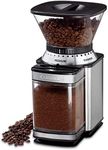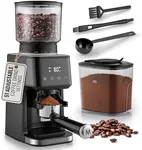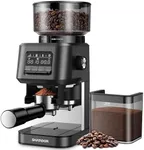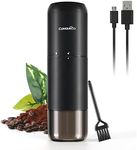Buying Guide for the Best New Coffee Grinders
Choosing the right coffee grinder can significantly impact the quality of your coffee. The right grinder will help you achieve the perfect grind size for your preferred brewing method, ensuring that you get the best flavor and aroma from your coffee beans. When selecting a coffee grinder, consider the following key specifications to find the best fit for your needs.Grind Size SettingsGrind size settings refer to the range of coarseness or fineness that a grinder can produce. This is important because different brewing methods require different grind sizes. For example, espresso requires a very fine grind, while French press needs a coarse grind. Grinders with multiple settings offer more versatility. If you enjoy experimenting with different brewing methods, look for a grinder with a wide range of settings. If you stick to one method, a grinder with fewer settings may suffice.
Burr vs. BladeCoffee grinders come with either burrs or blades. Burr grinders use two revolving abrasive surfaces to grind the beans, providing a more consistent grind size and better flavor extraction. Blade grinders use a spinning blade to chop the beans, which can result in uneven grind sizes. Burr grinders are generally preferred by coffee enthusiasts for their precision and consistency. If you are serious about your coffee, opt for a burr grinder. If you are looking for a more affordable and straightforward option, a blade grinder might be suitable.
Grind CapacityGrind capacity refers to the amount of coffee beans a grinder can hold and grind at one time. This is important if you regularly make coffee for multiple people or prefer to grind a larger batch at once. Grinders with larger capacities are convenient for households with multiple coffee drinkers or for those who entertain guests frequently. If you usually make coffee just for yourself, a grinder with a smaller capacity will be sufficient and may take up less counter space.
Grind SpeedGrind speed is the rate at which a grinder can process coffee beans. Faster grinders can save time, but they may generate more heat, which can affect the flavor of the coffee. Slower grinders tend to produce less heat and preserve the beans' flavor better. If you are in a hurry in the mornings, a faster grinder might be more convenient. However, if you prioritize flavor and quality, a slower grinder may be the better choice.
Ease of CleaningEase of cleaning refers to how simple it is to clean the grinder after use. Coffee grinders can accumulate oils and residues from the beans, which can affect the taste of future grinds if not cleaned regularly. Grinders with removable parts or those designed for easy disassembly are easier to clean. If you prefer low-maintenance appliances, look for a grinder that is easy to take apart and clean. Regular cleaning is essential to maintain the grinder's performance and the quality of your coffee.
Noise LevelNoise level refers to how loud the grinder is during operation. This can be an important consideration if you live with others or prefer a quieter environment. Burr grinders tend to be quieter than blade grinders. If you are sensitive to noise or often make coffee early in the morning or late at night, look for a grinder with a lower noise level. If noise is not a concern for you, this specification may be less important.





















